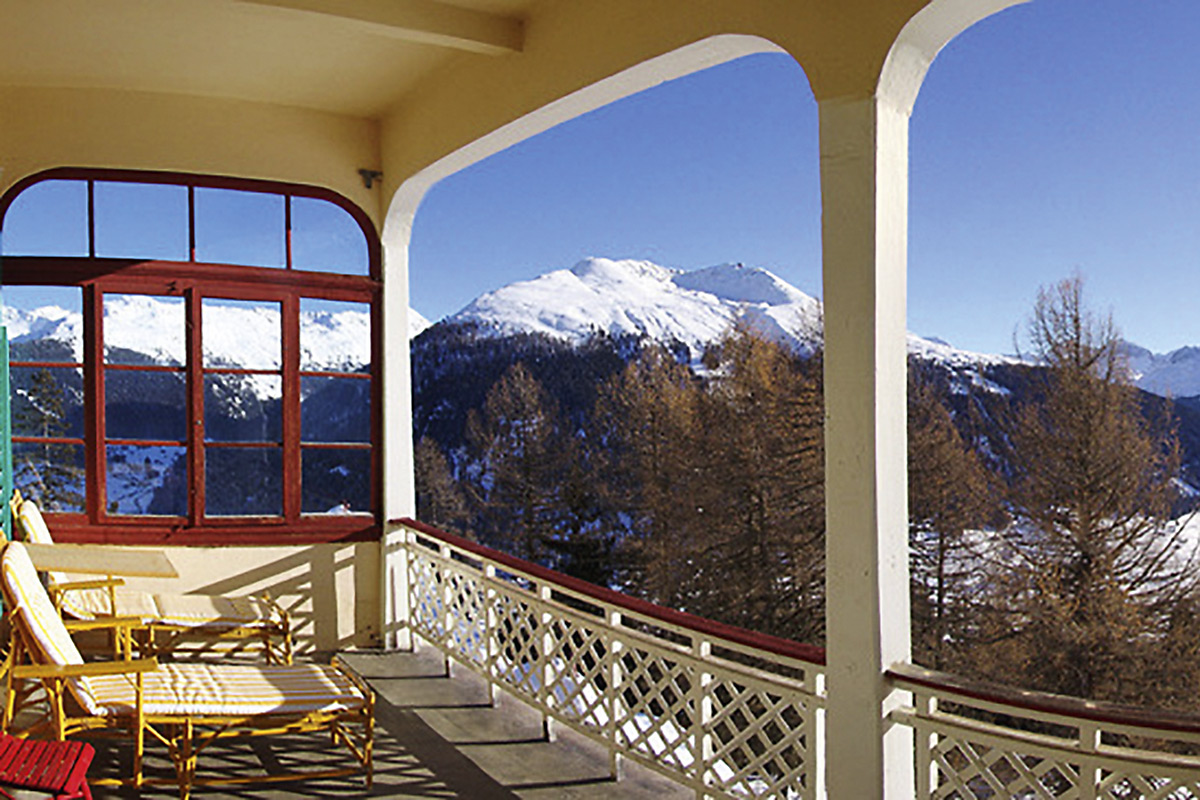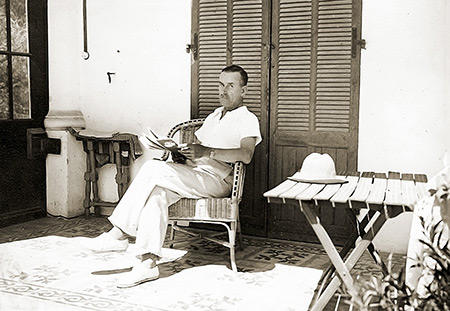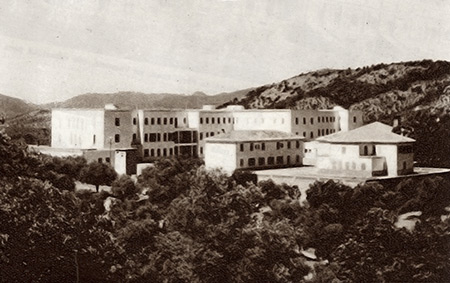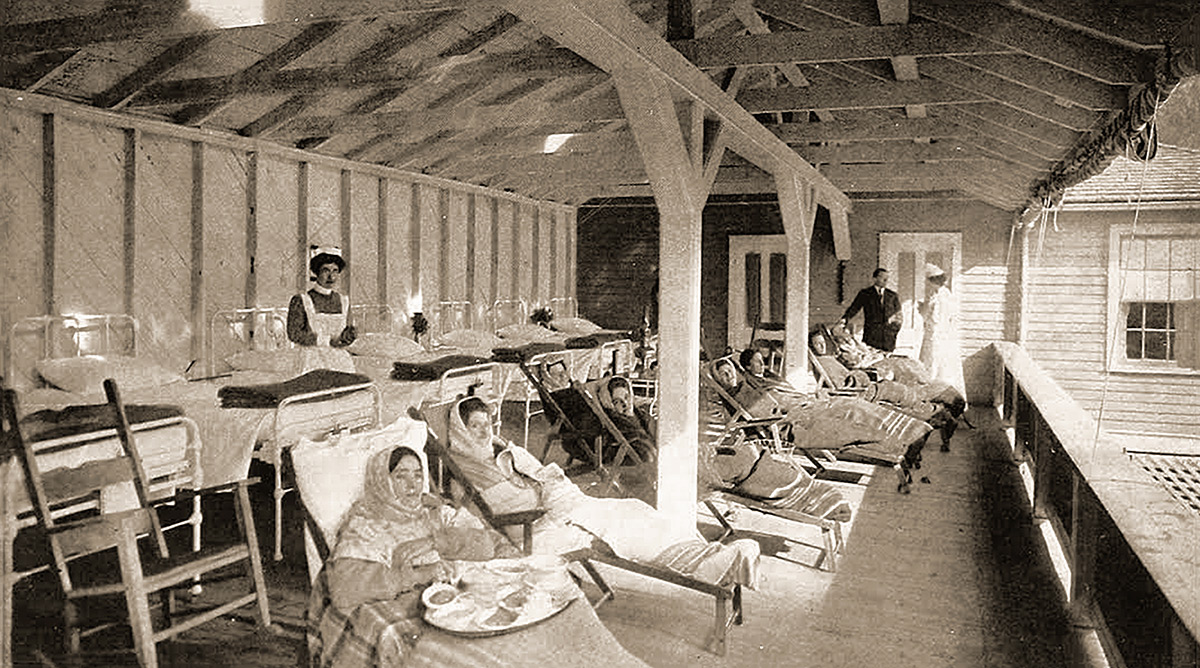
Literature and medicine are closely connected. Many works that portray experiences of disease have been set in health care facilities, including sanatoriums. Anti-tuberculosis sanatoriums, seen as spaces of isolation and as «death row» have inspired many authors. Twentieth-century novels devoted significant attention to these institutions which, kept far from the rest of society, conditioned both the life and the identity of the sick. The magic mountain by Thomas Mann and Rest home by Camilo José Cela are two outstanding references among these productions. In Catalan literature, El mar (The sea in its English language translation) by Majorcan author Blai Bonet must also be highlighted.
Keywords: novel, medicine, sanatorium, tuberculosis, space.
Sanatorium novels
Tuberculosis sounds like something from the past. With the hygiene measures prevalent in Western culture and with current therapies, we can consider it a residual disease that no longer represents a serious danger to our lives (Pérez Cruz, García Silveira, Pérez Cruz, & Samper Noa, 2009). But this was not always the case. Infection by these mycobacteria has accompanied humankind for thousands of years and until only a very few decades ago, still greatly impacted individuals and communities (Daniel, 2006). The perception of disease, both from societies and their literary reflections, has changed over time and across cultures, depending on the knowledge available about its causes and the therapies to be applied.
«During the nineteenth century, novels established tuberculosis as the quintessential literary disease»
During the nineteenth century, novels established tuberculosis as the quintessential literary disease. Think, for instance, of The lady of the camellias, by Alexandre Dumas fils (1848), adapted into opera in Verdi’s La traviata (1853). Since Koch’s discovery of Mycobacterium tuberculosis (1882) as the cause of the condition and the development of hygiene protocols to fight it, a period of confinement of tuberculosis and its patients started (Báguena Cervellera, 1992; Ledermann, 2003). Sanatoriums dedicated to curing the disease were important in several key European novels during the first half of the twentieth century, such as The magic mountain by Thomas Mann (1924) and Rest home by Camilo José Cela (1943).

Sanatoriums dedicated to curing tuberculosis were important in several key European novels during the first half of the twentieth century, such as in The magic mountain by Thomas Mann (1924) and Rest home by Camilo José Cela (1943). Above, Thomas Mann in a picture taken in Sanary-sur-Mer (France) in 1933. / Wikimedia
The magic mountain is set in a Swiss tuberculosis sanatorium, where the main character spends seven years. The monotonous routine of curative activities moves the interest of the novel towards the world of personal intellectual and emotional experience, caused on the one hand by pain and insecurity about the future, and on the other, by the isolation and confinement of the space. The German author presents a wide array of characters that help delve into different aspects of topical European issues.
In Cela’s novel, Rest home, set in Spain after the Civil War, the central space is also a sanatorium to treat tuberculosis, a choice that we must relate with the personal experience of the author, who stayed in these institutions twice. Even though there is almost no communication between patients, we can consider the sanatorium from their perspective because they express their fears, hopes, and other reflections by writing letters, diaries, and memoirs.
Framed within Catalan literature, apart from the work of Màrius Torres, a great poet who was infected with tuberculosis and wrote during the Civil War and the post-war era, Blai Bonet (1926–1997) stands out. Best known as a poet, he published the novel El mar (The sea in its English language translation) in 1958, influenced by the two works mentioned above. It was adapted into a film with the same title by Agustí Villaronga in 2000.
But what was the influence of the sanatorium in the behaviour and life of these literary characters? In this institution, exclusion, isolation, the disease, and sometimes the coming of death to remove patients not only from society, but also from the group dynamics that are considered «normal». Novels set in a sanatorium take us deep into the spatial organisation and mechanics of these institutions, into the time perception of the patients, into medical procedures and the contrast between death in the inside and life in the outside.
«The sanatorium is the space where writers, often personally, experience the severity of the disease»
The sanatorium space
In recent years, space or spatiality (the preferred term for some authors) has gained ground as a social construction among the topics of literary study. Thus, theorists such as Westphal (2011), Bou (2013), or Tally (2017), among others, focus their literary analysis on elements related to spaces. Therefore, authors become «creative cartographers, and their creation contributes to configuring the collective imagination» (Salvador & Piquer, 2016, p. 169). The line of research that studies the importance of spatiality in the literary imagination is often called geocriticism or spatial literary studies, among other names.

In the case of Catalan literature, The sea (1958) by Blai Bonet is the reference work. It allows us to get closer to a masterful recreation of the anguish imposed on each character by the sanatorium space. / Blai Bonet photographic archive. Mallorca Literària Foundation
Spaces are connected to identities, memory, and individual and collective history. In many novels, the tuberculosis sanatorium is the setting for collective drama. This medical institution is not only the setting for the events, it determines everything. On the one hand, patients are forced to leave their environment, both emotional – family and friends – and spatial, i.e., their home and home town. On the other, the location makes them interact with others, including other patients or «healthy» people, represented mainly by the sanatorium staff. A dichotomy is created between people from outside of the sanatorium – the healthy – and the ones from inside – the sick.
At the sanatorium, tuberculous patients have a lot of free time to reflect upon their past – in the case of The sea, a past marked by war – but also on the uncertainty of their future. All the inhabitants of this space are completely aware that being admitted to this institution «was a sort of death sentence from which only a few would come back, more by chance than because of the effectiveness of the treatments» (Pérez, 2015, p. 236).
When we talk about sanatoriums – especially in literature – we cannot but think of the ones dedicated to tuberculosis patients. These spaces were modern and hygienic institutions with rules regarding rest and a good diet, especially compared to the hardships of a large part of society in post-war Spain. The model rest-home used to be far from the city and surrounded by nature, either in the mountains or at the seaside. This location had to ensure both separation from the rest of society and fresh air and serenity.

Aymà
Sanatoriums are a space of «otherness» – a heterotopia of deviation in Michel Foucault’s sense (1984) – in which the individual lives in detention and suffers a certain social exclusion. In this case, the reason for confinement is not a deviation from the social norm – as would be the case with prison or with a mental hospital. Individuals are confined in sanatoriums to separate and even hide tuberculosis patients, as described by Carbonetti (2000):
The sick were confused with the sickness and condemned to marginalisation, to being moved from the space of healthy people to the outskirts (to the mountains or the sanatorium), where no one but their equals, other tuberculous patients, could have contact with them.
In this sense, the disease establishes a stigmatising social stereotype for the outside world. Erving Goffman (1993, p. 15) characterises the stigmatised individual as the opposite of normal and stresses the fact that people tend to think that stigmatised individuals are not completely human, and so they are discriminated against, which actually reduces their chances of survival. The same thing occurred with people with tuberculous because the rest of society considered them a source of infection and, to some extent, dehumanised them. Thus, «tuberculosis was seen and perceived by society and the patient as the death row, not only for physical death, but also for social death» (Carbonetti, 2000).
«In many novels, the tuberculosis sanatorium is the setting for collective drama»
‘The sea’, by Blai Bonet
Blai Bonet, who had first-hand knowledge of the environment in these institutions, started writing the novel at the Caubet anti-tuberculosis sanatorium in Majorca (Spain). The version of The sea we know today, however, went through many changes before it was published. As Manel Haro (2015) remembers, Bonet has repeatedly denied that this was an autobiographical novel, but his life influences are more than clear in the text. The author joined a seminary when he was ten and had to leave seven years later because of tuberculosis. It is no coincidence, therefore, that disease and religion are the two axes of the book.

Blai Bonet, who had first-hand knowledge of the environment in these institutions, started writing the novel at the Caubet anti-tuberculosis sanatorium in Majorca (Spain). Above, photograph of the health care centre in 1949. / Image bank of the Spanish Royal Academy of Medicine
The sea tells the story of a group of teenagers suffering from tuberculosis and living in a sanatorium in Majorca after the war. The narrative often uses flashbacks to bring us to the patients’ childhood during the Civil War and the war traumas that mark the lives of the protagonists who end up in the sanatorium years later. There are more characters, but the main ones are two boys. They try to look for a way to face pain and their approaching death, but their mental balance is destabilised in different ways: in Manuel Tur’s case, with an obsession with God and in Andreu Ramallo’s, with violence.
In the case of teenagers, the stigma of being locked away in a sanatorium, disconnected from outside life, is an even greater obstacle for their development, since their age requires more socialisation. These are adolescents who, despite their youth, have known many horrors, from war and childhood murders to disease, suffering, and post-war famine. They only have each other, so close links are formed between them as well as with their carers. We must not forget, however, that their most intimate contact is with themselves. Perhaps this is why The sea contains so many monologues.
«Red represents danger, pain, and death»
Spaces in ‘The sea’
Bonet’s novel is primarily set in a space of the present, in an undefined and nameless sanatorium and with barely any clues to its location. However, its secondary space, called Argelús, contains the fictional community of the main characters which we are mainly told about when a time shift takes us to their past. Over the course of the novel, the readers discover more details about the sanatorium. We discover all these details via the four characters who tell the story. Thus, each chapter is named after the character-narrator chosen by Bonet and spaces are presented especially within their monologues.

Among the other spaces that appear not only in Bonet’s work, but also in other novels set in sanatoriums, are galleries and corridors. In the gallery, patients rest on chaise longues, waiting to be cured as the seasons go by. Above, a photograph of the Catawba sanatorium (Virginia, USA), featured in the book by Carrington, T. S., Tuberculosis hospitals and sanatorium construction (2011). / Internet Archive Book Images
Bedrooms and toilets are the sanatorium spaces that receive the most attention. In the case of rooms, we know about the inside and about what they see or hear through their windows. In the interior, the contrast of white and red stands out. Red is, among other things, the colour of blood, of the crosses the patients are marked with to indicate the seriousness of their condition, of the dress that Carmen the nurse wears when she has intercourse with Manuel, one of the patients. Ultimately, red represents danger, pain, and death. Conversely, the white of towels, bed linen, walls… symbolises hygiene and safety. But it is a very precarious safety, constantly threatened by blood, which may appear at any time.
Bedrooms are a place of rest, of waiting for drugs, for treatment, but also for death. As in Rest home, patients refer to each room using its number. In the case of Bonet, however, this is not as depersonalising as in Cela’s work, where we do not even know the names of the characters, only their room number. Nevertheless, numbers have a meaning in The sea: Room 13, for instance, frequently appears, and is associated with death. It is the place where the staff take boys who are close to death so that their roommates cannot see them.
Even so, let us not forget that patients usually stayed for months or even years in the sanatorium, as is the case of the protagonists of our story. Hence the importance of outside views. Bonet pays attention to this and, unlike the inside, the open and free outside space is described using many more colours. Thus, for patients the window and what they can see through it is often their only connection with the outside world. Boys, isolated from that world and with many hours of accumulated anxiety, see the window as an escape valve, a way to imagine how it would be to live on the outside, without the disease and the routine of the sanatorium. Therefore, the window stands as a symbol for freedom. What they see through it is a space with no limits or obstacles, it is pleasant and colourful, contrary to their «imprisonment», to uniformity, and to the sadness of the inside.
«A dichotomy is created between people from outside of the sanatorium – the healthy – and the ones from inside – the sick»
The toilets are another important space in the novel. They use pale colours, white and grey marble, which contrast with the red blood spat out by the patients. It is the space for reflection, where the boys contemplate themselves in the mirror. The mirror, as key element to help the individual look within, has been thoroughly studied. For Foucault (1984), in cases such as the one we describe, the mirror can represent an experience mixed between heterotopia (the «otherness» space of the sanatorium) and utopia (a location without a real space). On the one hand, what we see is undoubtedly a utopia, an unreal, empty space where the character does not exist, but on the other, it is also a heterotopia, because when someone looks at it, it reflects the space it occupies exactly as it is, in real time.

Blai Bonet has repeatedly denied that The sea was an autobiographical novel, but his life influences are more than clear in the text. / Blai Bonet photographic archive. Mallorca Literària Foundation
Among the other spaces that appear not only in Bonet’s work, but also in other novels set in sanatoriums, there are the galleries and corridors. In the gallery, patients rest on chaise longues, waiting to be cured as the seasons go by. These comfortable hammocks are associated with the sanatorium space because the sun and fresh air are healing elements. However, despite the hygiene of fresh air and the views, the gallery is yet another section of this «imprisonment» – a semi-external one, nonetheless. The corridor is a transit area, a common space. They need to cross it to go to the toilet and there, the repetitive routine of the sanatorium is more present than anywhere else. It often becomes one of the scenarios of death because the cart that takes corpses out also crosses the corridor.
Life in a sanatorium consists of a loop that develops between the aforementioned spaces: patients come in, their physical condition worsens, then their mental state follows, they die, and new ones arrive. For this reason, in Rest home patients only have a number instead of a name. What we see in The sea is a part of the sanatorium story, a fragment following the lives of the characters, but after the protagonists die the sanatorium continues, and so does the cycle of life and death, even though readers do not see it. Life inside, therefore, is so monotonous that it becomes unbearable for the teenagers, to the point that they think that anything would be better than the routine, as described by one of the characters:
El dia que em posaven la sonda gàstrica, jo em considerava superior als altres. Sempre passen aquestes coses. En els llocs on existeix un reglament, sortir de la rutina, anc que sigui una molèstia, se considera sempre una superioritat.1
(Bonet, 2011, p. 186).
The sanatorium is, therefore, the space where writers, often personally, experience the severity of the disease, the limit between life and omnipresent death, and the confinement within the anti-tuberculosis institution. Individuals behave in accordance to the space in which they find themselves because it determines their interpersonal relationships and establishes a stigmatising social stereotype with the outside world.
«European literatures have used the environment of these types of institutions and their uncertainty regarding the future to depict the fragility of human beings when facing an almost inevitable death»
In this claustrophobic kingdom, patients, uprooted from their previous life, become isolated individuals, often forgotten by everyone. Their inner life gains intensity and, despite their youth, forces them to change and mature. European literatures have used the environment of these types of institutions and their uncertainty regarding the future to depict the fragility of human beings when facing an almost inevitable death, and in the case of Catalan literature, The sea is the reference work. It allows us to get closer to a masterful recreation of the anguish imposed on each character by the sanatorium space, with many implications for the history of medicine and the social imagination around health and disease.
1. «The day I got the stomach tube, I felt superior to the rest. This always happens. In places with regulations, getting out of the routine, even if it is a nuisance, is always considered superior». Translated by MSSJ. ( Go back )
REFERENCES
Báguena Cervellera, M. J. (1992). La tuberculosis y su historia. Barcelona: Fundación Uriach 1838.
Bonet, B. (2011). El mar. Barcelona: Club Editor.
Bou, E. (2013). Invention of space. City, travel and literature. Madrid/Frankfurt: Iberoamericana/Vervuert.
Carbonetti, A. C. A. (2000). La tuberculosis en la literatura argentina: Tres ejemplos a través de la novela el cuento y la poesía. História, Ciências, Saúde-Manguinhos, 6(3), 479–492. doi: 10.1590/S0104-59702000000400001
Daniel, T. M. (2006). The history of tuberculosis. Respiratory Medicine, 100(11), 1862–1870. doi: 10.1016/j.rmed.2006.08.006
Foucault, M. (1984). Des espaces autres (conférence au Cercle d’études architecturales, 14 mars 1967). Architecture, Mouvement, Continuité, 5, 46–49. Retrieved from https://foucault.info/doc/documents/heterotopia/foucault-heterotopia-en-html
Goffman, E. (1993). Estigma: La identidad deteriorada. Buenos Aires: Editorial Amorrortu.
Haro, M. (2015, 4 March). Una capbussada a El mar de Blai Bonet. Llegir en cas d’incendi. Retrieved from http://www.llegirencasdincendi.cat/2015/03/una-capbussada-a-el-mar-de-blai-bonet
Koch, R. (1882). Die Aetiologie der Tuberculose. Berliner Klinische Wochenschrift, 15, 221–230.
Ledermann, W. (2003). La tuberculosis después del descubrimiento de Koch. Revista Chilena de Infectología, 20, 48–50. doi: 10.4067/S0716-10182003020200015
Pérez, O. A. (2015). Una aproximación biopolítica a la narrativa de la posguerra: La tuberculosis en Pabellón de reposo de Camilo José Cela y El mar de Blai Bonet. Hispania, 98(2), 231–242. doi: 10.1353/hpn.2015.0052
Pérez Cruz, H., García Silveira, E., Pérez Cruz, N., & Samper Noa, J. A. (2009). Historia de la lucha antituberculosa. Revista Habanera de Ciencias Médicas, 8(2). Retrieved from http://scielo.sld.cu/scielo.php?script=sci_arttext&pid=S1729-519X2009000200003&lng=es&tlng=es
Salvador, V., & Piquer, A. (2016). Els llocs en l’imaginari literari: L’espai valencià i els altres (presentació del dossier). Ehumanista/IVITRA, 10, 169.
Tally, R. (2017). The Routledge handbook of literature and space. London: Routledge.
Westphal, B. (2011). Geocriticism: Real and fictional spaces. New York: Palgrave MacMillan.





